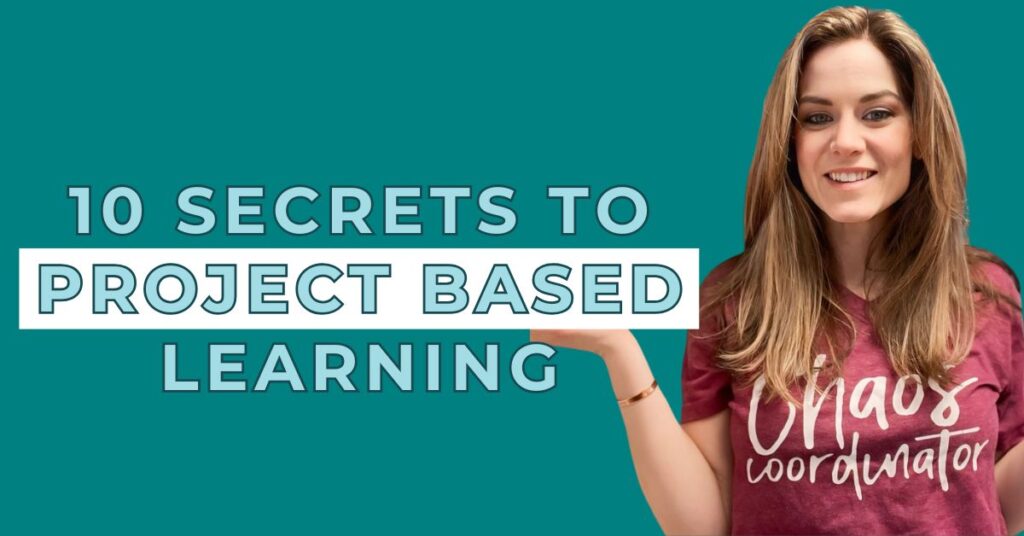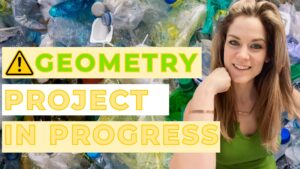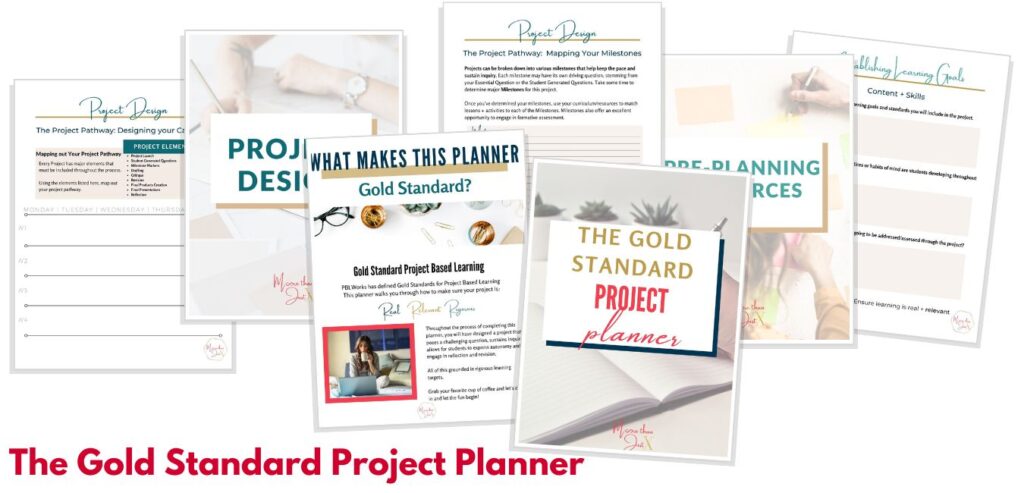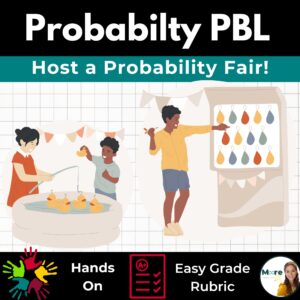Sometimes, project-based learning can feel like a puzzle with missing pieces—especially when you’re trying to make it work in a math classroom.
How do you launch a successful project-based learning experience? How do you find time for PBL when there are so many standards to cover? And most importantly—how do you ensure your students are actually learning math?
Here at Moore than Just X, I don’t believe in keeping secrets. That’s why this guide lays it all out for you: 10 Secrets to Success for making project-based learning in math engaging, effective, and manageable.
Need to know if the topic you’re teaching is right for PBL?
Download our free Expert Guide to Teaching with Projects or Practice now!
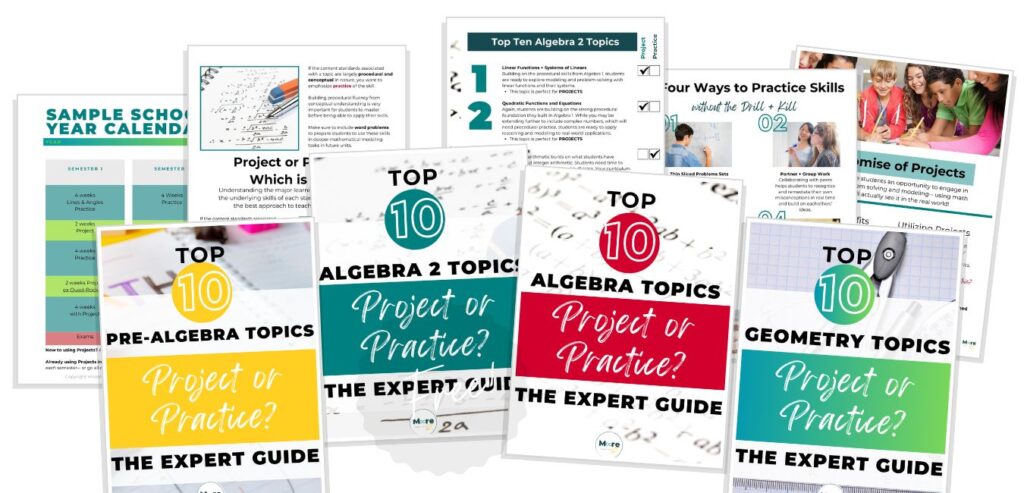
Project Based Learning Definitions
Before we do a deep dive on the 10 secrets to rocking PBL in your math classroom, let’s ensure we’re all on the same page by defining key terminology.
Project
A project is an application of learning typically found at the end of a unit, where students are tasked with creating something related to the unit of study.
Projects are important because they give students an opportunity to apply math concepts in fun, creative, and novel ways. However, these end-of-unit projects may not address all math standards.
Use caution to ensure strong learning target alignment if using a project as an assessment. If full alignment isn’t there, consider using the project as a formative assessment or classwork grade instead. 
Here is one of my favorite examples of a great end of unit project for Algebra 1!
Read about this fun, hands on, linear equations project here!
Project Based Learning (PBL)
Project-Based Learning (PBL) is a teaching approach where students explore real-world, relevant problems over an extended period, learning key math skills through problem-solving, collaboration, and hands-on application rather than traditional lecture-based instruction.
PBL is important because it makes math meaningful, shifts students from passive learners to active problem-solvers, and builds critical thinking skills.
The key difference between a project and PBL? A project is often a single task at the end of a unit, while PBL is the vehicle for learning throughout the unit.
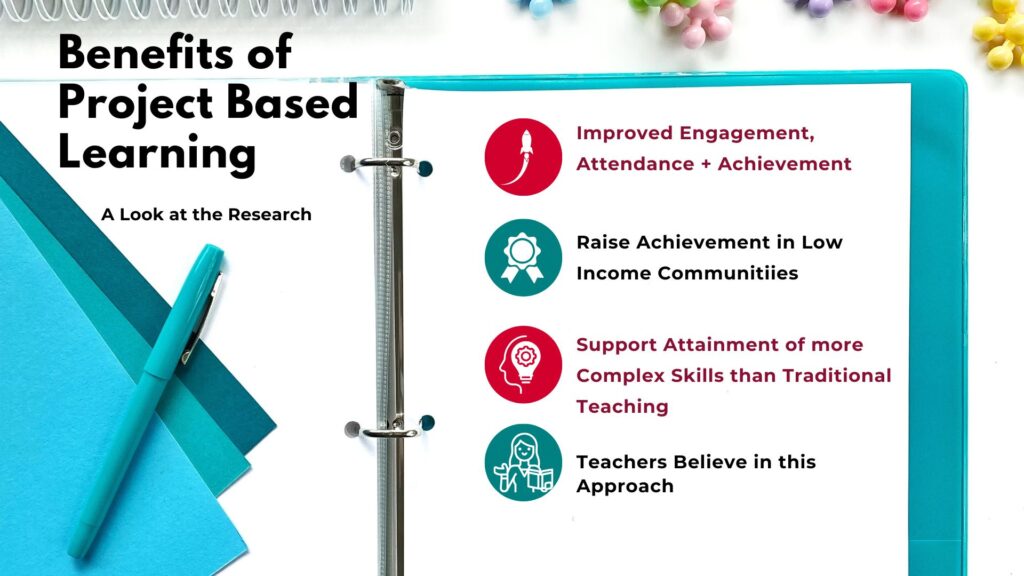
Project Phase or Project Stage
A project phase is a distinct stage in the PBL process that helps break the project into manageable steps. Common phases include:
- Project Launch (introducing the challenge or problem)
- Inquiry & Exploration (students ask questions, research, and experiment)
- Skill-Building (direct instruction and practice)
- Product Development (students create their final work)
- Culminating Event (students present their learning)
Why are project phases important? Project phases are important because they give structure to what could otherwise feel overwhelming and help students stay on track. Well-structured phases make PBL successful, rather than chaotic.
Project Launch
The project launch is the hook that introduces students to the challenge or problem they’ll be solving. A great project launch sparks curiosity, builds engagement, and makes students want to dive in. A strong launch could include:
- A compelling video or scenario
- A guest speaker or expert
- A hands-on experiment
- A real-world challenge that impacts their lives
Project launches are important because they set the stage for deep learning. If students don’t care about the problem, they won’t care about the math.
Listen in to the Modern Math Teacher’s podcast “Project in Progress” Episode to see how I launched the Wasted Space Geometry Project!
Entry Event
An entry event is the first exposure students get to the project—a moment designed to grab their attention and get them asking questions.
What is the purpose of an entry event? Entry events are important because they set the tone for the project. If the entry event is boring, students will assume the project is boring, too. A great entry event makes students go, “Wait… we get to do THAT in math class?!”
Driving Question
A driving question is the big, open-ended question that frames the entire project. It should be thought-provoking, inquiry-driven, and connected to real-world math.
Weak driving question: Can you solve these quadratic equations?
Strong driving question: How can we design a basketball shot with the perfect arc using quadratic functions?
Why are driving questions helpful? Driving questions are important because they guide students’ curiosity and keep them focused on solving a meaningful problem. If your question doesn’t spark interest, your project will fall flat.
Milestone
A milestone is a checkpoint within a project that helps students track progress and develop essential components step by step. Think of milestones as mini-goals leading up to the final product.
Why are project milestones useful?Milestones are important because they keep students from procrastinating and provide natural moments for feedback and improvement. If you don’t set clear milestones, your project will turn into a last-minute scramble.
Product
A product is the final creation students develop as part of the project. This could be a:
- Mathematical model or simulation
- Data analysis report
- Business proposal or financial plan
- Blueprint or design for a real-world solution
Why are final products important? Products are important because they allow students to demonstrate their math skills in meaningful ways. A great product is not just “fluff” or an arts-and-crafts project—it should showcase real mathematical thinking and reasoning.
Culminating Event
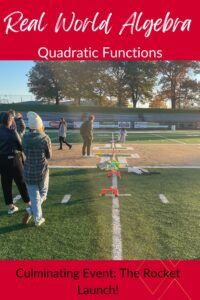
The culminating event is the final stage of the project where students showcase their learning in an authentic way. This could be:
- A presentation to an audience (not just the teacher!)
- A published report, video, or infographic
- A product that solves a real-world problem
Culminating events are important because they give students a real sense of purpose and motivation to do high-quality work. If students know their work will be seen beyond the classroom, they take it more seriously.
Authentic Audience
An authentic audience is someone beyond the teacher who will see and engage with students’ final products. This could be:
- Community members or local businesses
- Engineers, data analysts, or other professionals
- Younger students in need of a mentor
Why is it important to have an authentic audience? Authentic audiences are important because they raise the stakes for students and make their work feel valuable. Students care more when they know their work has a real-world impact.
Inquiry Based Learning
Inquiry-based learning is a student-driven approach where learners ask their own questions, explore possibilities, and discover answers on their own before formal instruction.
Why is inquiry-based learning it important? Inquiry-based learning is important because it builds problem-solving skills and keeps students engaged. When students figure things out for themselves, they’re more likely to remember and understand the material. Instead of telling students the formula, let them discover it.
Scaffolding
Scaffolding is the support teachers put in place to help students stay on track and succeed in a project. This could include:
- Mini-lessons on key math skills
- Checklists and graphic organizers
- Structured peer feedback
Why is it important to scaffold in a project? Scaffolding is important because not all students will naturally know how to tackle a project. Good scaffolding ensures success without taking away student ownership.
Formative Assessments
Formative assessment is ongoing feedback that helps students improve their work before the final product. It can include:
- Teacher check-ins
- Peer reviews
- Self-reflection journals
Why is formative assessment it important? Formative assessments are important because they help students grow throughout the process, not just get a grade at the end. No one does their best work in a single draft!
Summative Assessments
Summative assessment is the final evaluation of student learning, usually based on the culminating event and/or final product.
Why is summative assessment important? Summative assessment is important because it measures student mastery of both the math content and the PBL process. But if PBL is done well, students should already have plenty of formative feedback before this final step.
Student Agency
Student agency is the level of choice and control students have over their learning. This could include:
- Choosing their final product format
- Deciding how to collect and analyze data
- Selecting their own real-world problem to solve
Why is student agency important?Student agency is important because it increases engagement and ownership. When students feel like their learning is theirs, not just something being handed to them, they take it more seriously.
Secret #1. If You Plan with the End in Mind, You Will Create More Impactful Projects
We’re starting simple here on our list of 10 secrets about project based learning in the math classroom.
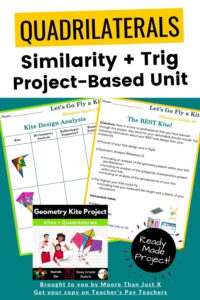
The reason planning with the end in mind works for designing project based learning units is that we need to ensure our project is going to meet the instructional goals we have. We know time is limited and there is certainly no shortage of learning targets in the math curriculum. So we’ve got to be really intentional about what we are designing.
One coaching client was stuck trying to figure out how to teach quadrilaterals in a fun and engaging way. She was feeling frustrated that the projects she had tried in the past, just hadn’t yielded the high learning results she had hoped for.
As soon as she worked backward from her final assessment to unpacking the necessary skills she needed students to have mastered, she found re-designing her kite project into a project based learning to be just what the students needed to make the connection between the quadrilaterals in the text books and exam, and the kites they were building and flying in class!
Before you discount this because your students aren’t going to fly kites or the content you’re teaching doesn’t seem quite as hands-on, consider what authentic applications do exist for your topic, and the joy you’ll feel when you don’t have students asking “When am I ever going to need this?”
Secret #2: Make Sure You Choose a Real World Application Students Care about
I hate to break it to you, but if the project doesn’t feel relevant, students won’t engage. You should always have a thorough understanding of your students interests and aspirations– think sports, social issues, technology, or even local community problems—to make math come alive
To help you out with this, we have an incredible tool on student interests that makes finding these connections a snap . 🔗Check it out here: Student Interest Inventory!
Now that we’ve got an idea that is real and relevant for our students. It’s time to come up with an incredible project launch.
The launch is the hook! If the project doesn’t connect to students’ interests, they won’t engage. A strong launch grabs attention and sparks curiosity.
If you are struggling with identifying relevant real world applications for algebra topics (or you know, select your course of choice!), you may want to consider things like:
- Why is this topic important in the real world?
- How will this help them in future learning or applications beyond school?
- How has this topic helped you or someone you know?
Still stumped? Ask my bff ChatGPT or your favorite AI to help you brainstorm some ideas!
Secret #3. Sometimes You Have to Give up Control (and that’s a good thing)
I’m sure we’ve all seen classes posted on Instagram where every student seems engaged and on task. They are all happily doing exactly the same work and the teacher appears to be in full control of the classroom.
These stories are a little exaggerated to say the least. I’ve never been in a class like that. And here’s the real truth about working your way through project based learning– it is messy. BUT it is manageable!
Now that you have designed a project your students will love, you will need to let the students explore.
For example:
When my Algebra 2 students are working on their Save for Success project, it’s not uncommon to see some of them avidly searching Xello on their Chromebooks. Others are on their phones scouring the internet trying to find banks with the lowest student loan interest rates–shouting out their findings to classmates. And still others are actively searching up their current bank balances and texting their parents that they’ve got to find a way to save more money for school. Each student is engaged in part of the process. They are taking ownership of their learning and discovering where and how mathematics is going to be most meaningful for them. It’s days like this I don my invisible crown and proudly wear my favorite “Chaos Coordinator” shirt.
🔗Check out this Instagram Post all about the Save for Success Project
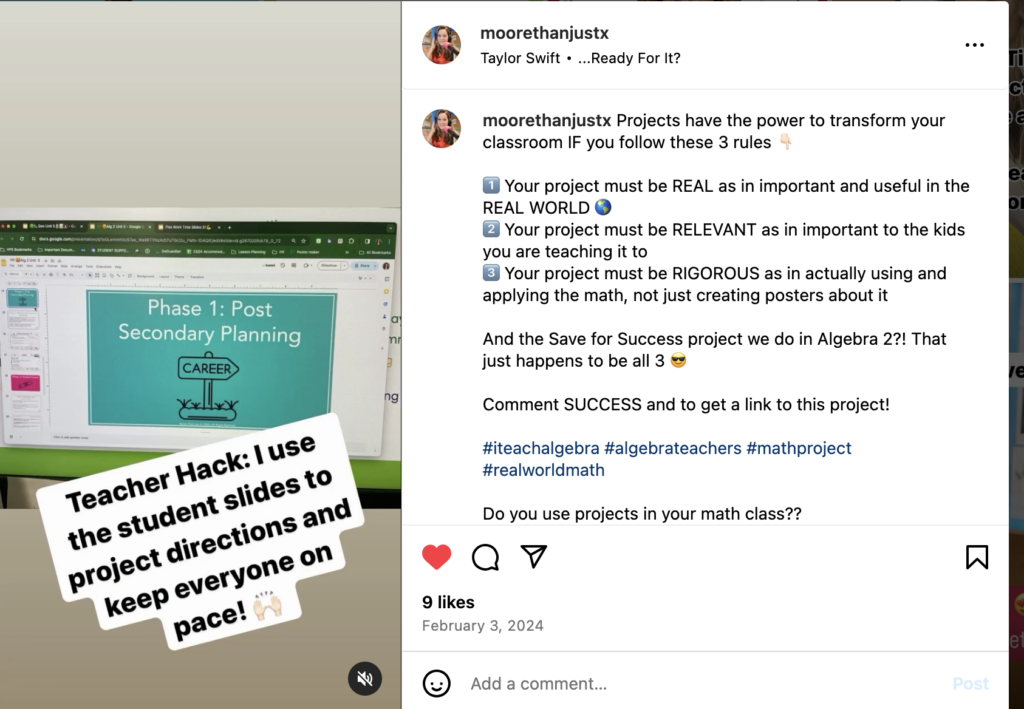
PBL isn’t about handing students a scripted set of tasks. It’s about empowering them to explore, struggle productively, and make decisions. Yes, it will feel messy at first—but that’s how real learning happens.
Project-based learning thrives when students have choice and ownership (you know that student agency we talked about before?). It can feel uncomfortable at first, but letting students explore and make decisions leads to deeper learning.
Can you give up the reins of control for just a bit my friend?
Secret #4: Understand How Inquiry Based Learning Leads to Deeper Understanding
It’s widely known that inquiry-based learning and creating an opportunity for building thinking classrooms is essential in math class, but that doesn’t mean that letting students explore on their own means they’ll magically learn everything without guidance.
It’s easy to default to direct instruction too quickly, especially when students struggle with open-ended problems and seem frustrated or lost. As teachers, our instinct is often to step in and “fix” things, but in reality, productive struggle is a key part of learning.
We have a 3-step plan to make inquiry-driven learning successful in your PBL classroom:
Step 1: Shift Your Role from Instructor to Facilitator: Be the Chaos Coordinator!
Instead of jumping in with answers, respond with guiding questions. When a student says, “I don’t know where to start,” resist the urge to explain immediately. Instead, ask:
- “What do you already know?”
- “What do you think is the first step?”
- “Can you try a different approach and test it?”
This small shift builds student confidence and problem-solving skills.
Step 2: Give Students Support with Framework to Follow
Many students struggle with open-ended learning because they don’t know how to ask good questions or organize their thinking. Teach them a simple framework like:
- What do I already know?
- What do I need to find out?
- What are possible ways to solve this problem?
This structured approach keeps inquiry focused and productive.
Step 3: Normalize Mistakes and Encourage Reflection
Students need to see mistakes as learning opportunities, not failures. Regularly ask:
- “What worked well?”
- “What didn’t work, and why?”
- “What would you do differently next time?”
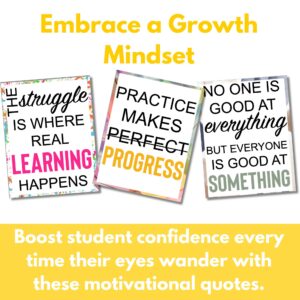
By modeling and celebrating a growth mindset, students feel safe to explore and take risks—critical for deep understanding.
Inquiry isn’t about letting students figure it all out alone—it’s about creating the right conditions for them to discover, question, and build understanding at their own pace. When we embrace inquiry-driven learning, we shift from simply teaching math to helping students think like mathematicians.
Secret #5. Don’t Worry about Covering all Standards in one Project
But, Kristen, I thought I had to teach every single learning target in my pacing guide?
While it is important to give your students exposure to all of the learning targets in your course, if you get caught up in worrying about covering all of the standards in one project, you will become worse at teaching them.
Not every project will hit every single standard, and that’s okay! Strategic scaffolding ensures students still build necessary skills throughout the process.
Let me give you an example. When I first started creating my own project based learning units. I would spend a lot of time worrying about the number of standards I had to teach and how many of them were going to actually fit in with this project. All this worrying took up time I could have spent enjoying the early days of my marriage and motherhood.
And when I was in class trying to run the project? I fell to quick “word-vomit instruction” just to make sure I ticked all the boxes and we had “covered” all the standards within the one project. I didn’t have the scaffolding set up to ensure my students could succeed.
My friend, what a terrible way to teach. Instead of worrying about addressing ALL the standards, here’s some quick advice to help you design projects that provide your students with the rigor you expect, without the word vomit you don’t.
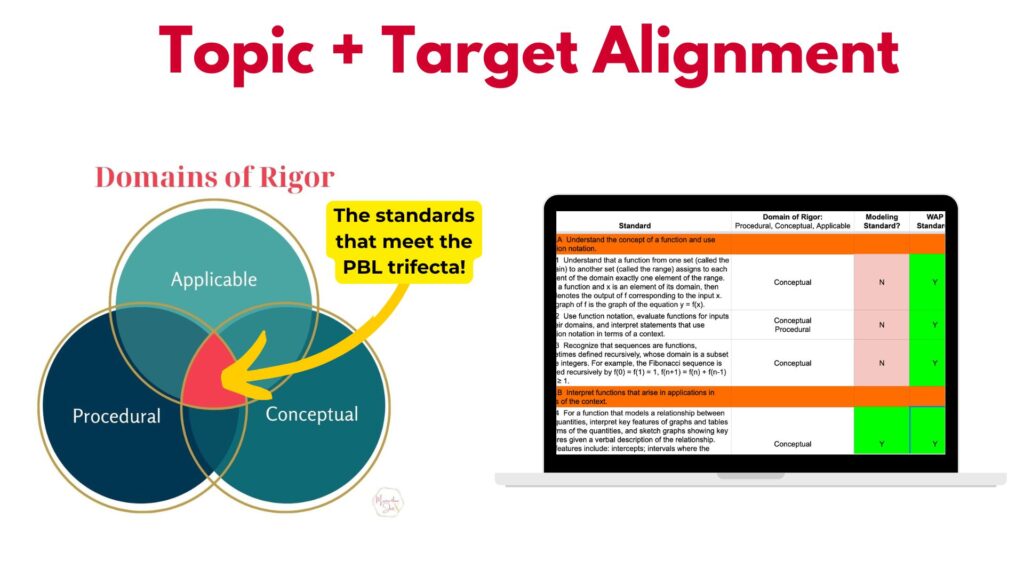
Math project based learning is best when the standards are….
- Aligned to two or three of the Domains of Rigor (Procedural Skills, Conceptual Understanding and Applications)– if you’re going for two make sure Applications is one of them!
- One of the Widely Applicable Pre-Requisistes- aka the skills that are most needed for success in post-secondary education and careers.
- Scaffolded to ensure success– build in opportunities for students to learn and apply new skills throughout the project, not just in one chunk. This gives students an opportunity to learn more of the associated skills, even if they aren’t going to fully master them in the project.
Not sure how well aligned your project standards are? We’ve got a handy tool to help you out: CCSS Standards Breakdown for Middle or High School Teachers.
Still not sure if the topic you’re teaching should be turned into a project? Download our handy dandy Expert Guide to Projects or Practice: available for Pre-Algebra, Algebra 1, Geometry and Algebra 2!
Secret #6. Every Successful PBL Teacher has a Strong Feedback System
You know that teacher—the one whose PBL projects run smoothly, effortlessly, and with zero chaos (at least, that’s how it looks from the outside). Their students are engaged, their projects actually get finished, and the work is impressive enough to showcase at school events.
That could be you if you master one of the most overlooked elements of PBL: a strong feedback system.
Ask any successful PBL teacher, and they probably won’t tell you that the secret to running a great project is a perfectly planned lesson or the best real-world connections (although those help!). Instead, it’s about continuous, structured feedback. Without it, projects can quickly turn into a confusing mess, with students missing key learning moments along the way.
Understanding how feedback drives success will help you keep students on track, improve their work over time, and create truly meaningful learning experiences.
Here’s how to build a strong feedback system in your PBL classroom:
Step 1: Build in Milestones for Checkpoints (Not Just a Final Grade)
Projects shouldn’t be a one-and-done thing where students work for weeks and only get feedback at the end. Instead, break projects into smaller milestones with structured check-ins:
- Checkpoint #1: Proposal or Initial Plan (Are they clear on the problem they’re solving?)
- Checkpoint #2: Rough Draft or Prototype (Is the math making sense? Are they applying concepts correctly?)
- Checkpoint #3: Final Refinements (Before the big presentation, what needs tweaking?)
Want a deeper look at project milestones? Check out this PBL Planning Guide I’ve Created!
Step 2: Use Peer Feedback (It’s More Powerful Than You Think!)
Students value peer feedback more than we often realize—sometimes even more than teacher feedback! Build structured peer review into your project phases using:
- Gallery walks where students review and critique each other’s work.
- Peer feedback forms with sentence starters (“One strength I see is…” “One area for improvement is…”).
- Think-Pair-Share discussions where students explain their work and get suggestions.
Peer feedback reinforces learning because students have to evaluate math critically, not just solve problems.
Want strategies for effective peer feedback? Edutopia has a great post on it here.
Step 3: Normalize Revisions & Growth Over Time
In a PBL classroom, the first draft is never the final draft. If students treat feedback as an “I messed up” moment instead of a learning opportunity, they won’t engage in the process.
Help students see revision as a natural part of learning by:
- Giving them structured revision opportunities (“After this checkpoint, you’ll have time to improve your work before final submission.”)
- Celebrating growth, not just final products (“Look how much stronger this data analysis is compared to your first attempt!”)
- Using reflection questions to reinforce improvement (“What changes did you make? How did feedback help you?”)
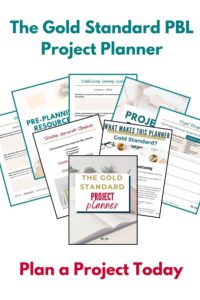 The best PBL teachers aren’t just facilitators of projects—they’re facilitators of feedback. When students get meaningful, ongoing feedback, they produce better work, understand concepts more deeply, and gain confidence in their math skills.
The best PBL teachers aren’t just facilitators of projects—they’re facilitators of feedback. When students get meaningful, ongoing feedback, they produce better work, understand concepts more deeply, and gain confidence in their math skills.
Make Sure to Grab The PBL Gold Standard Planner to help plan out your next PBL unit!
Secret #7. Check for Overly Complicated or Unclear Instructions
You may have an eye on creating the perfect real-world math project, but have you considered how clear your instructions actually are?
Instructional clarity is the silent game-changer in PBL success. In other words, even the most engaging, real-world, well-designed project will fall apart if students don’t understand what they’re supposed to do.
This can help you with Project-Based Learning by minimizing confusion, maximizing engagement, and keeping students focused on the math instead of wasting time figuring out directions—so you spend less time reteaching, students stay on track independently, and your project runs more smoothly from start to finish.
How to Make Sure Your PBL Instructions Are Crystal Clear
1️⃣ Be Explicit About the End Goal
Before students even start, they should have a clear answer to:
- What are we creating? (The final product)
- Why does this matter? (The real-world purpose)
- How will we be assessed? (Expectations & grading)
If students don’t know what they’re working toward, they’ll struggle with everything in between. A strong project launch should eliminate ambiguity.
2️⃣ Break the Project into Steps with Milestone Checkpoints
Instead of dumping everything on students at once, guide them through clear, manageable steps. Use:
- Project timelines with milestone due dates
- Step-by-step instructions (with visuals or examples!)
- Scaffolding tools like graphic organizers or checklists
This helps prevent overwhelm and makes the project feel achievable.
3️⃣ Test Your Instructions (Before It’s Too Late!)
A simple way to catch confusing directions is to do a soft launch with students. Ask:
- “Can you explain the project to a partner?”
- “What’s the first step?”
- “Where do you feel stuck?”
If multiple students struggle with the same step, your instructions need tweaking.
The best PBL projects aren’t just engaging—they’re clear, structured, and easy for students to navigate. When directions are confusing, students waste time figuring out what to do instead of actually doing the math.
Secret #8. You Can Make Math More Hands on than You Think!
We live in a world that is all about utilizing technology and getting immediate satisfaction, but sometimes getting our hands messy is exactly what we need to make those connections really stick.
A strong entry event (like modeling a real-world scenario, guest speaker, or experiment) helps students see math in action and get excited about what they’re about to learn.
When teaching my students about exponential growth and the spread of disease, we got our hands dirty– literally! For our entry event, my students got hands-on math applications with GloGerm powder– a little on one hand, plus a few minutes of high-fiving our classmates and a quick shut off of the lights revealed just how quickly germs can travel. Creating a table, graph and function became no problem once students experienced the thrill of exponential growth in action.
To put this into practice in your own math classroom, try:
1️⃣ Probability Project: Run a Classroom Casino 🎲
Kick off a probability project by transforming your classroom into a mini casino with dice games, card draws, or spinning wheels. Have students play, record outcomes, and make predictions before introducing probability rules and expected values. Once they experience the randomness firsthand, calculating probabilities will feel way more relevant!
2️⃣ Quadratic Functions: Paper Airplane Flight Test ✈️ 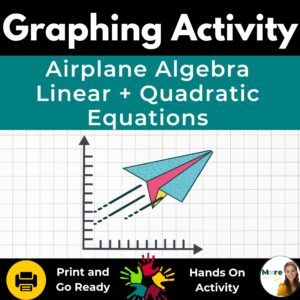
Launch a quadratic functions project with a paper airplane contest. Have students predict which designs will fly the farthest, then measure distances and track flight paths. As they collect data, guide them to see how the motion follows a parabolic arc—leading perfectly into quadratic graphing and equations. Grab this paper airplane freebie here!
3️⃣ Geometry Transformations: Human Coordinate Plane 🔢
Bring geometry transformations to life by creating a giant coordinate plane on the floor (tape or chalk outside). Have students stand in different quadrant positions and physically translate, reflect, rotate, and dilate themselves based on given rules. Once they move through transformations, plotting them on paper makes way more sense!
Do you have another top-secret idea for hands-on entry events? Please share it in the comments below or over in the Modern Math Teacher’s Facebook Group!
Secret #9. You’ve Got to Trust the Process
Are people pushing you to see instant results from PBL? Maybe it’s your own inner voice whispering, “If they don’t get it right away, I must be doing something wrong.”
Unfortunately, this is a common struggle when shifting to project-based learning. Traditional teaching gives us quick, visible proof of learning (like a worksheet with correct answers), while PBL takes time to u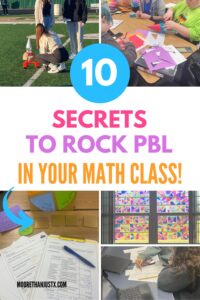 nfold.
nfold.
But here’s the danger—if you expect perfection too soon, you might panic, overcorrect, or give up on the project before students reach that “aha” moment.
However, this doesn’t mean that you’re failing or that PBL isn’t working—it just means students need time, support, and space to struggle productively.
Some suggestions to stay the course:
✔ Redefine Success – Progress in PBL doesn’t always look like neatly completed work. Instead, listen for deeper conversations, curiosity, and problem-solving. That’s real growth!
✔ Celebrate the Small Wins – Maybe students finally connected a math concept to a real-world scenario or asked a great inquiry question. Those moments matter—acknowledge them!
✔ Keep Your Eyes on the Culminating Event – A showcase or presentation brings everything together. Even if the process feels messy, chaotic, or uncertain along the way, trust that students will get there. That final moment of seeing them explain, apply, and own their learning makes it all worth it!
Pro Tip: Keep a “PBL Wins” Journal—a place where you jot down moments when students show understanding, collaborate well, or make a breakthrough. On tough days, look back and remind yourself why you’re doing this.
Secret #10. The Best Projects have a REAL Audience (not just the Teacher!)
Is your mind blown by this one? Mine was, too!
Inviting REAL people to participate sets you up for success in designing and implementing effective project based learning!
When students share their work beyond the classroom, they take it more seriously. A real audience increases motivation and makes learning feel meaningful.
I found that when a project lived and died in a classroom, students’ engagement in the project process, and their outcome varied from student to student. There I was, dreaming of a classroom full of active and engaged learning, not one where students were passive and their energy came and went in spurts.
I knew I needed to find a way to up the ante for my students. They needed a little more skin in the game. Enter: the authentic audience.
When I invited community members in to help assess students “businesses” , they took more care in developing their plans and creating their demo products. When students found out their kites were going to be flown by real kids at a community event? Their kites became that much more stable and creative.
What ended up helping me really get my students actively engaged in learning mathematics was showing them someone else cared about the work they did.
Let’s Wrap this Up!
Project-Based Learning in math isn’t about following a rigid formula—it’s about creating meaningful, real-world experiences that engage students and deepen their understanding of mathematics. When you design with the end in mind, give students ownership, scaffold effectively, and trust the process, you set the stage for learning that sticks far beyond a single lesson or test.
 I’m all about helping middle and high school math teachers achieve the active and engaged classroom of their dreams. My hope is that this post gives you everything you need to start implementing project based learning and skyrocket student engagement (and achievement!) in your classrooms today.
I’m all about helping middle and high school math teachers achieve the active and engaged classroom of their dreams. My hope is that this post gives you everything you need to start implementing project based learning and skyrocket student engagement (and achievement!) in your classrooms today.
Remember, the best PBL classrooms don’t just teach math—they bring it to life. Whether it’s launching an engaging entry event, building a strong feedback system, or connecting students with a real audience, these 10 secrets will help you move from theory to action in making PBL work in your math classroom. Now, it’s your turn—which of these secrets will you put into practice first?
Want to know more about project based learning and other effective instructional strategies? There are 4 ways we can help:
- Join our Facebook group here and network with other secondary math teachers who are bringing project based learning to life in their math classrooms
- If you want to stay up to date on all of today’s best teaching strategies for math teachers, listen to 🎙The Modern Math Teacher on your favorite podcast app.
- Check out my past projects in progress @MoorethanJustX on Instagram
- If you haven’t already downloaded our Project Based Learning Gold Standard Planner, click here to grab it now so you can get started.

